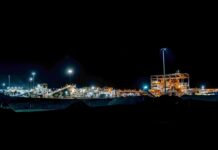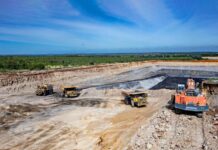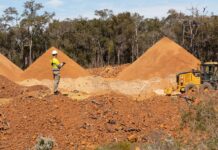SINCE 2001, the Wallaby deposit has been delivering ore to the Granny Smith mill, marking 30 years of continuous production; and in 2019, Granny Smith looks set to deliver another milestone as it installs one of the world’s largest solar PV micro-grids.
In 2013, Granny Smith changed hands when Gold Fields purchased 100 per cent of the mine from GSM as a part of its Yilgarn South operations purchase.
Today, the mining at Granny Smith takes place underground at the Wallaby deposit, where Gold Fields uses the inclined room and pillar (IRP) method for mining in areas with a moderate dip, and transverse long-hole stoping (TLHS) in zones with variable dips.
The ore is transported 12km from the Wallaby underground mine to the 3mtpa processing plant at Granny Smith, which operates a two-stage crushing circuit with a standard SAG and ball mill grinding circuit, a gravity circuit, a leach/carbon in pulp train, a pressure Zadra elution circuit and tailings facilities.
The Wallaby deposit is currently operating at a depth of 1.2km underground, and in 2018 Gold Fields spent $25 million on exploration to extend the life of the mine.
In the first quarter of 2019, as gold prices reached near-record heights, Granny Smith under-produced.
In its quarterly report, the company said that it was due to a decrease in the production of stoping fronts “as a result of the geotechnically controlled mining sequence”.
This “mining sequence” resulted in a 14 per cent reduction of ore processed, which lowered the overall gold production by 2 per cent, from 71,000oz in the December 2019 quarter to 69,300oz.
The ore that was mined increased the gold yield by 14pc from 4.77 to 5.42 grams per tonne, which the company attributed to the higher head grade that was mined.
And a reduction ore processing facilitated a reduction in production costs.
The cost of sales, before amortisation and depreciation was down 10pc from $61m to $55m, and capital expenditure was steady at $21m, as was the AISC of $1204/oz.
Gold Fields said it had allowed for this reduction in production in its annual guidance and when Granny Smith and the Gruyere project reach capacity, the company’s Australian assets would again deliver strong results.
Getting off-grid
As a part of its mission to reduce emissions, Gold Fields has increasingly turned to renewable energy.
The company will use Granny Smith as a prototype, retrofitting the mine with hybrid technology, and build Australia’s largest solar PV hybrid micro-grid.
The microgrid will be built by Scottish firm Aggreko, which was responsible for the conversion of the mine from diesel to LNG in 2016.
As a solar-LNG hybrid, the grid would integrate with the existing 24.2MW LNG generation plant, with construction to begin in May 2019, and work expected to reach completion in the December quarter of 2019.
Aggreko will design, construct and install what will be one of the world’s largest micro grids.
The hybrid solar PV and battery technology would have an eight megawatt (MW) capacity from the planned 20,000 solar panel solar plant, and a would be backed by a 2MW/1MWh battery system.
Gold Fields executive vice president, Stuart Mathews, said it would be a welcome addition to the company’s suite of on-site energy solutions across other operations, enabling it to reduce the carbon footprint.
The company believes that the renewables would generate nearly enough power to run the mine’s processing operations, and the solar-plus-battery system could potentially reduce fuel consumption by up to 13 per cent and produce about 18 gigawatts (GW) of energy per year.
Aggreko AusPac managing director George Whits said this was the equivalent of removing 2000 cars from the road.
The current LNG power station at Granny Smith was upgraded from diesel and installed by Aggreko in 2016, and the new hybrid power system would combine with a thermal station expansion to create a 24.2MW capability.
Solar PV would reduce the needs of Gold Fields to run thermal generators and the battery plant would provide essential services such as “spinning reserve displacement, PV ramp rate control and transient voltage/frequency support,” Aggreko said.
Of the 24.2MW generated, about 12MW would be allocated to the Wallaby mine and the remaining 12MW allocated to the processing plant and the associated facilities and mining camp.
“We expect the renewable power microgrid will be up and running at Granny Smith by Q4 2019 and it will be a welcome addition to our suite of on-site energy solutions across other operations which will enable us to reduce our carbon footprint,” Mr Mathews said.






















